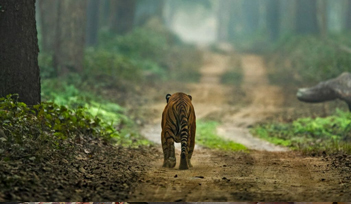Home > Butterflies of Dudhwa National Park
Butterflies of Dudhwa National Park
Butterflies have always been a subject of interest, and they are probably next only to birds in their universal popularity. This is partly attributable to the great variety and beauty of their colour patterns and partly to their dramatic transformation during their life cycle and the interesting phenomena of mimicry and migration.
There are about 1500 species of butterflies in India. They vary greatly in colour, habits and size. The largest butterfly, the Southern irdwing has a wingspan of up to 19 cm, while the smallest the Grass Jewel has a wingspan of 1.5 cm. Dudhwa Tiger Reserve has approx. 43 species of them.
A butterfly is a winged insect belonging to the Phylum Arthropoda, class Insecta and order Lepidoptera. The wings of butterflies are covered with tiny scales arranged like rooftiles. A butterfly, like other insects has three main body divisions - head, thorax and abdomen. The six legs and four wings that are found in a typical insect are present in a butterfly. In fact, insects are the only invertebrates that can fly.
The division of Lepidoptera into moths and butterflies, though convenient, has little scientific validity. The two groups can be differentiated on the basis of several superficial distinctions. Broadly - butterflies fly by day, while moths are active after sunset. There are of course, several exceptions.
VARIATION
Variation within species of butterflies is quite common, in size, shape, colour and also behaviour patterns. These variations are attributable to both genetic and non-genetic factors.
PROTECTIVE ADAPTATION
Butterflies at all stages face the prospect of attack by predators. To escape from their enemies and to protect themselves, butterflies have developed various devices, starting right from the caterpillar stage. Most caterpillars come in shades of green and brown, whcih camouflage them among their food plants. The effect is further enchanced by their being marked with lines very much like the veins of leaf, or by lateral lines that optically break up their body pattern among the blades of grass.
MIMICRY
Many butterflies escape attack because they taste unpleasant. Milkweed butterflies and some Swallowtails store in their adult bodies poisonous fluids which have been produced by the larvae consuming poisonous plants.
To escape predators, some butterflies have evolved bright and warning colours and conspicuous pattern like those of unpalatabe species. Despite all their protective adaptations many butterflies right form the egg stage to the adult stage, do fall prey to birds, lizards, frogs and other predators. As butterflies provide food for other creatures, their position in the web of life is vital and nature has found ways to protect them.
MIGRATION
Some butterflies migrate like birds. It is amazing that a tiny creature like butterfly can make arduous and long journeys but ofter the swarms of butterflies during migration are unimaginably large, tens of thousands or even more. Their numbers thus far surpass even the most massive migrations of birds, mammals or fish. What is more baffling is that these journeys are usually one way and the travellers do not ruturn ot the place of their birth at all. It is the next generation that returns. How, then do they find their way back? Several questions in relation to insect migration have still remained unanswered.
In India two type of migration have been observed. In one of the two, at irregular intervals, thousands of butterflies of a particular species are seen flying in streams in a definite direction. These are mainly Milkweed butterflies, and Yellows and Whites. Hordes of caterpillars of these butterflies have been noticed stripping all the available food plants bare to the extent thatthe successor breed is left without adequate plants on which to lay eggs. This induces them to move out in search of areas having enough food plants to support the next generation.
The other type of migration takes place regularly mainly to avoid unfavourable weather conditions and is common among those species that are found in hills.
Butterflies are found in a variety of habitats, they hold an important place in the web of life being closely associated with plant life. There presence or absence serves to monitor ecological changes in habitat, thus warning us about the deterioration in the environment.
INTERESTING FACTS
- Butterflies are chief pollinators of the flowers on which they feed upon including some of our major food crops. So, they ensure food secutity for us.
- In temperate countries most adult butterflies feed on flower nectar, although some will visit sap runs, or imbibe dissolved mineral salts from dung, damp earth or carrion. In the tropics many Nymphalids feed at rotting fruit,while Swallowtails and Sulphurs prefer to drink from urine-soaked ground, and many Hesperiine skippers are noted for feeding at bird droppings.
- The powdery substance on the wings of butterflies is actually their tiny sacles which are arranged like roof tiles and are easily rubbed off when touched.
- Some butterflies are poisonous; therefore they are not predated upon.
- Besides nectar, butterflies also feed upon overripe fruits and decaying organic matter.
- Butterflies drink contaminated water, sweat, urine and excreta in damp patches to replenish their salt requirements.
- Some butterflies exude a variety of aroma such as that of sandalwood and musk.
- A butterfly needs to warm its body in sun (basking) before being able to take on a flight.
- Some butterflies migrate to better feeding and breeding places but unlike birds, return journey (to an area originally vacated by their parents) is made only by the offspring.
- In a protected area butterflies are equally important like other species. They form the preferred food of many species of birds, reptiles, spiders and predatory insects, hence are important components of food chain.









